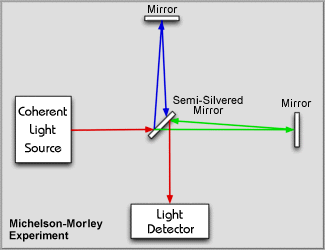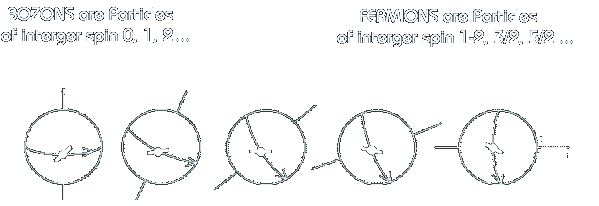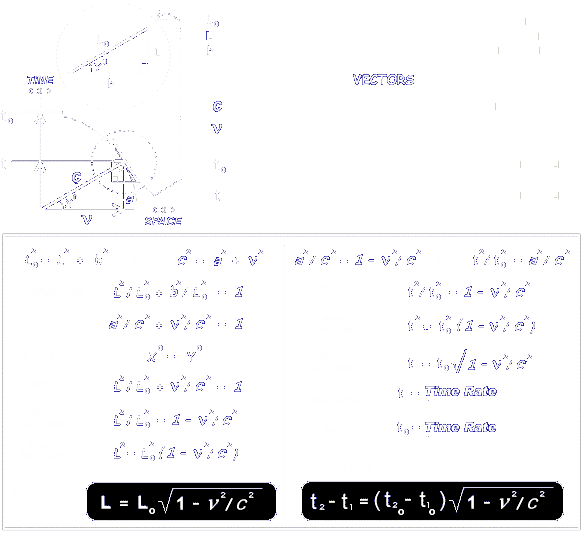|
So far, we
have learned that all particles are actually always moving at the constant speed, " c ".
Therefore Constant Acceleration is almost identical to Centrifugal Force, since it too is
actually a constant change in direction of travel while still maintaining that constant " c
" motion in the four dimensional TIME-SPACE reality. We, on the other hand, despite this
constant motion, see changes in the speed of an objects spatial motion. This is because we
can not look across the time dimension, but instead exist only in the present, and so any
changes in the direction of travel within Time-Space are seen by us as an increase or
decrease of the motion across the spatial dimension only.
Subtract the
view of one dimension and you have the Birth of all Variables.
Therefore it
is to be understood that when you drive your car, you are only changing its direction of
travel when you hit the brakes or when you step on the accelerator, and that the car itself
actually has constant motion in Time - Space. By stepping on the brakes, or stepping on the
accelerator, you are changing the direction of travel of your car in that Time - Space. And
so in truth, you can never really Park your car. Therefore you can only receive a parking
ticket for setting your cars direction of travel to be the same as the direction of travel
of the surrounding objects which in this case are the streets. A speeding ticket is
therefore what you receive if your angle of departure in Time - Space, exceeds acceptable
limits.
In the LAND
OF PHYSICS, the speed of LIGHT is also described as the (c)onstant known as " c ". Is it just a coincidence that a Logical analysis of motion produces
a " c " constant as well ? The speed of light is described as being the fastest
possible speed, and nothing can move any faster. Is this true as well ?
The next step
is an LIGHT analysis

Looking back
in history, it was observed that if measuring the speed of light, even when measured under
any circumstances, the results were always the same 300,000 km per second. For example, if
you were able to throw a ball at a speed of 50 miles per hour and at the same time while
throwing that ball you were on top of a train traveling in the same direction at 70 miles
per hour, the end result would be that the ball would be traveling at 120 miles per hour
relative to the ground or to a stationary observer the train was approaching. However, it
was observed long ago that this did not apply to light. If instead you placed a flashlight
on the train that is traveling at 70 miles an hour, pointing the flashlight in the same
direction of travel, one would assume that the speed of light relative to the ground or a
stationary observer, would be the speed at which the light left the flashlight plus the 70
miles per hour of the train. However, if you were not on the train, and you measured the
speed of the light from a stationary point of view, the outcome was still the same 300,000
kilometers per second even though the source of the light was in motion at 70 miles an hour
relative to you.
Light speed
measurement, was somehow always consistent !!!
On top of
that, to simulate the above example, only in this case simulating being on the train, in
1887, Michelson and Morley performed tests that revealed that the apparent speed of light on
the earth's surface, is not influenced by the earth's motion around the sun. If equipment
was set up on the earth's surface to measure this consistent light speed, it did not matter
which direction the light path was pointing, it did not matter whether it was with or
against the direction the earth was traveling as it circled the sun, nor did it matter if
the path was set sideways, the light speed was always measured as 300,000 km per second.
However it is to be noted that under all the measurement conditions of this experiment,
Earth is still on the move, therefore this test has only established that the measured speed
of light is isotropic under these conditions. Therefore, we are not simulating the
measurement of the speed of light taken both on the train and also off the train, but it is
simply the direction of the measurement taken, relative to the train, or Earth on the move,
that is being changed. And so, because of this, we can not say that if we took measurements
while onboard the train, and also took measurements while not onboard the train, that we
would obtain the same measurement results. This was put to the test at another
date.
Michelson and
Morley performed tests that revealed that the apparent speed of light on the earth's
surface, is not influenced by the variation in speed of the earth's motion around the sun.
This time they placed the tests six months apart such that one test takes place as the
earth's orbit around the sun was it its maximum speed, and the other test was taken while
the earth was at its minimum orbital speed. Once again, no differences were measured when
comparing the results. However, it is to be noted that the experiment only verified that the
speed of light had still passed the test of being Isotropic under these two test conditions,
and that as shown in the diagram below, the Michelson-Morley (MM) test uses Round-Trip light
paths as part of the experiment, therefore it does not compare light speed in one direction
to the light speed in the opposite direction, but compares one Round-Trip pointing in one
direction to another Round-Trip pointing at a 90 degree angle relative to the first, and it
is only monitoring the constructive and destructive interference that is based on the length
of the arms, rather than actually measuring the speed of light. Any differences that were to
be detected, were to show as a fringe shift in the interference pattern created by the
constructive and destructive interference.

The first
step taken to partially explain this Round-Trip isotropic consistency of these earth bound
measurements, was the result of a mathematical analysis of the situation, an analysis which
implied that it must be the actual measurement instruments themselves that change when in
motion. The (L)ength of a ruler, for instance, would actually become shorter if
pointing in the direction of the earth's motion, or if on our train that is traveling at 70
MPH. This would then provide an explanation for the consistent 300,000 kilometers per second
measurements.
Today this is
known as the Lorentz-FitzGerald Contraction Equation, the very equation used by
Einstein.

LOOK FAMILIAR
?
Yet
mathematics is just a tool. As a result of this, the somewhat reliable explanations were
achieved by physicists, but not fully understood. It did not explain why the contraction
occurred and it did not reveal the (c)onstant Motion of all objects! In my case, the
first step taken is the analyzing of motion itself using simplistic thinking such that no
small, and therefore simple, detail is overlooked, and I have therefore dismissed any use of
the complex tool known as mathematics as part of that simplistic analysis. Instead, I have
used this tool to convert my understanding of motion, into equations. My
understanding of motion in turn created the very same Contraction
equation.
Am I on to
something ?
At a later
time period, it was verified that the passing of Time slows down the faster one moves
through space. In this case, two Atomic Clocks were compared. One was on the Earth's
surface, and the other was loaded on to an airplane which then circled the planet. One
Atomic Clock was therefore moving through space faster than the other. And sure enough,
despite the extreme accuracy and stability of Atomic Clocks, the two clocks were no longer
in sync once the plane was in the air, and the final outcome, being the different time
reading between the two clocks once the plane had landed, could be explained by the
following time period ( t2 - t1 ) contraction equation. The time period experienced
on the airplane had become shorter than the time period measured on Earth, hence the Atomic
clock on the airplane had indicated less passage of time when compared to the time period
measured at the Atomic clock positioned on Earth.

LOOK FAMILIAR
?
My
understanding of motion created the very same Time Period contraction
equation.
Am I on to
something ?
Note: Today,
people are still using the brick age mentality, and so the equation that refers to the
slowing down of Time, is today described as the Time Dilation equation. This implies that
clocks are still ticking at their usual rate, but magically, Time itself has dilated, thus
the rate of the clocks ticking is stretched across this new imaginary dilated Time
dimension. My equation above, on the other hand, simply calculates the reduction of the rate
of the passage of time. This reduction occurs since the clock is no longer traveling across
the fixed dimension of Time as quickly as previously, and this is due to its constant motion
now being directed more across the dimension of Space and less across the dimension of Time.
As Fig. #4 illustrates, an increased motion across Space creates a reduced motion across the
dimension of Time. The dimension of Time of the Time-Space continuum, has NOT been
dilated.
At this
point, which was prior to me completing grade ten, I borrowed a grade 12 Physics text book,
to see if my equations had any value, and was tickled pink to find out that they were
identical to those used by Einstein despite the difference of the " Time Dilation " title.
The remaining pages were also completed prior to the completion of grade 10. Not having any
education in Physics can and does prevent one from repeating the same mistakes of others, by
not supporting ones theories upon flawed knowledge that belong to
others.
Note: Because
my thoughts, my simplistic thoughts, lead me to creating these very same equations, then
there is no choice but to scrap them. Society says that simplistic thinking is always
nothing but another meaningless case of SIMPLISM. What ever simplistic thinking reveals, it
is always to be thrown away due to the social acceptance of the idea that all simplistic
explanations are actually nothing but cases of over simplification.
Naturally,
society is quite insane. The number of Laws of Physics required to create reality, or the
universe as you see it, is less than the number of components within that universe. The
complex programs running on your Computer right now, still exist even though the (C)entral
(P)rocessing (U)nit within that computer can only make use of its severely limited number of
extremely simple command functions known as operations. The computer does not have to be
able to know of all the programs, and their complete usefulness, that the computer is
exposed to within its life time, for it to be able to perform them. No.
Instead, a very very simple (C)entral (P)rocessing (U)nit is all that is required to perform
complex programs that are far more complex than the CPU itself.
At the
FOUNDATION of EVERYTHING, there is always a SIMPLICITY
!
By ignoring
the foundation, meaning ignoring the simplicity, a completeness of understanding can not be
achieved. Also, when the simple pieces of the puzzle are assembled, once again one has
achieved simplicity, as the final picture is constructed. Therefore, if you ignore
simplicity, then the beginning and the end are both left outside of your present
reach.
Let's get
back to the analysis of reality. We have discovered that particles are four dimensional and
therefore we must ask ourselves if this informs us of anything else. Also, even though Logic
says that all objects or particles have a consistent and fixed motion in Time-Space, this
still does not explain the consistency of the measurement of the Speed of Light ( 300,000 km
per sec. ) that results no matter what spatial speed the source of the light itself also
has, nor the speed of the platform on which the light measurements are taken, and so we must
ask ourselves what it is that we are still missing.
MORE SEARCHING
TO DO !
The next
step, FOUR DIMENSIONAL PARTICLES ??

Understanding
that particles are four dimensional, gives another important but simple understanding.
Today's physicists state that some particles are known to have peculiar spin
properties. For instance, a particle which is known to have a half spin property, is a
particle that must rotate twice for its face to return to its original position. As shown in
Fig. #6 below, if a dot-/ is placed on the particle, it would not be
back to that same position and orientation unless the particle had rotated twice on its
axis.
How can this
be ?
The
only explanation is that the axis itself
is actually not just a spatial axis. If the axis tilts across the dimension of time as well,
then not only does the dot-/ move through space during the rotation, but also moves through
the dimension of time. The dot-/ will rotate around both spatially and rotate
forward(+) and backward(-) across the time dimension. With only one rotation, the 1/2 spin
particle then becomes a negative of itself ! It is not until it has completed a
second rotation that it returns to being in its original self state. Our observations of the
spin of a particle, are always taken from a limited point of view, a Relativistic point of
view, here in the present time. Therefore, we can not see the complete Holistic view of a so
called 1/2 spin particle, spinning in Time-Space.
To put it
another way, from our point of view, One Holistic Time-Space rotation = Two Relativistic
rotations.
or, 1/2 of a Holistic Time-Space
rotation = One Relativistic rotation.
Note: Once again, even if there is a case of an apparent spatial
axis only, we observe this relativistically, meaning we can not state that an object, or
particle, actually has an axis extending across space only, just as we can not say that a
particle is truly at rest in space, but instead, relativistically it may appear to have only
a spatial axis.

FIG. #
6
Different
Holistic axis angles in Time-Space, will determine the different limited Relativistic
interpretations of these spin properties. It is to be noted that many different Holistic
axis angles will appear to be the 1/2 or the -1/2 spin property from the limited
Relativistic point of view.
Now since
particles are four dimensional, and their spin extends across both Space and Time,
interference between the Time-Space path of one moving particle and another, could produce
some interesting interference patterns ! This will be discussed later on the " EVENTS
" page.
These
different Holistic axis angles also can be seen as different particle charges. If a particle
appears to have an angular spin of " c ", or " OTHER ", it is to be noted that this is only
the observed spatial spin of " c " or " OTHER " angular momentum. If a photon hits this
particle, then additional momentum is transferred to this particle, yet at the same time the
particles spatial angular momentum spin does not change at all. How is this possible
? It is possible because the additional force causes the axis of the particle to be
shifted, thus extending further across the dimension of time, while the remaining percentage
of the angular spin extending across space, the percentage being observed, STILL has the
angular momentum of " c " or " OTHER ". Therefore the holistic angular momentum is now
greater than its original angular momentum, but spatially, all is the
same.
This also
applies to electrons which are orbiting around the nucleus of an atom. Again if the electron
is struck by a photon, the electron is raised to a higher charge level, meaning its orbital
axis has changed Holistically, yet it also still retains the same angular momentum across
only space. This change of the Holistic axis can occur many times over if struck by
additional Photons. When the electron falls back to its previous level, it has returned to
its previous Holistic angular momentum, and has released a Photon energy packet. Again this
may be repeated if the Holistic axis angle in Time-Space had been changed several times
over. Due to particles moving forward and backward across time as they Holistically spin,
this also explains how the so called Quantum leap can occur, and explains exactly what a
Quantum leap actually is.
Concerning
Electrons, it is known that the axis of an electron can be rotated if the electron is placed
within a magnetic field. The axis will line up with that magnetic field. However, it is to
be noted that changing of the direction in which the axis points, does not mean that one has
changed the axis angle extending across time, the Time- Space axis angle, but one has only
changed the specific direction in which this Time- Space axis angle extends across
space.
|




